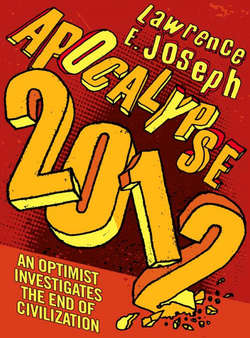Читать книгу Apocalypse 2012: An optimist investigates the end of civilization - Lawrence Joseph E. - Страница 7
GRAY GOO
ОглавлениеThere’s always a risk of unanticipated outcomes with new inventions—for example, the “gray goo” scenario that they try not to talk much about, up the road at Los Alamos National Laboratory, famed as the atom bomb’s birthplace. Los Alamos is a leader in nanotechnology, which seeks to create nanoscale (billionth of a meter) machines designed to behave like the ribosomes in the cells of our body, assembling complex structures, such as proteins, out of simpler compounds, such as nitrogen, a key component. Nanotechnologists have discovered that, given the right circumstances, the atoms of certain elements naturally assemble themselves into complex structures; germanium atoms will, like cheerleaders at a football game, climb on top of each other to form a pyramid, defying the natural tendency of most atoms, and most noncheerleaders, to give in to gravity and remain on the ground. This self-assembly property proves quite convenient for all sorts of nanoscale endeavors, from breeding ultrapowerful computer chips from bacteria to creating infinitesimal machines that can be injected into the bloodstream to eat up cancers or infections.
What if the nanomachines’ appetites got out of control? The result would be gray goo, a term coined by nanotechnology pioneer Eric Drexler, in Engines of Creation. Gray goo is a hypothetical nanosubstance that keeps on reproducing itself until it devours all the carbon, hydrogen, and whatever other elements it lusts for and has gooed over the face of the Earth. Imagine the parts of a box of Tinkertoys, carefully laid out on the right kind of mat, assembling themselves into, say, a Tinkertoy robot. Kind of cool. But now imagine that process going haywire, Tinkertoy Robot #1 making Tinkertoy Robot #2, and then those two making two more, and then those four making four more, with the numbers doubling into the thousands, millions, billions, in a runaway process that would continue until the world’s raw materials were consumed.
According to Drexler, rapidly self-replicating nanomachines could outweigh the Earth in less than two days. The good news is that something would undoubtedly come along to devour the gray goo. The bad news of course is that there would then be untold gray goo devourers to deal with.
Save the world. Destroy the world. It’s all pretty much the same ambition—that is, to prove beyond a shadow of a doubt the absurd proposition that life is divided into two roughly equal halves: oneself, and the rest of the Universe.
Strangelet black holes Pac-Manning the Earth. Priobots infesting our brains. Gray goo engulfing Life as we know it. Way too weird to lose any sleep over, but a man can dream. Ever since kindergarten days, when I and Marty Raichalk would spend hours in the backyard of the house our families shared on a dirt road in Danbury, Connecticut, protecting our imaginary girlfriends, Betty and Sue, from crazed murderers and bumblebees, I’d been waiting, you know, for an opportunity to show off my skills. In grade school I ached to take on the Martians plotting to steal my brain. One’s valuables must be safeguarded, for the sake of all decent people. And who knows how much evil could have been vaporized if Victor and I had ever managed to plug in that atom smasher?
Not to say that Vulcan, if we ever really get it up and running, won’t prove lucrative. But that’s just milkshake, and what we’re talking here is pure malted ego, so rich you can sip yourself into a coma. To save the world from poisoning itself, the planet and the people. Now that would be taking a bow.
